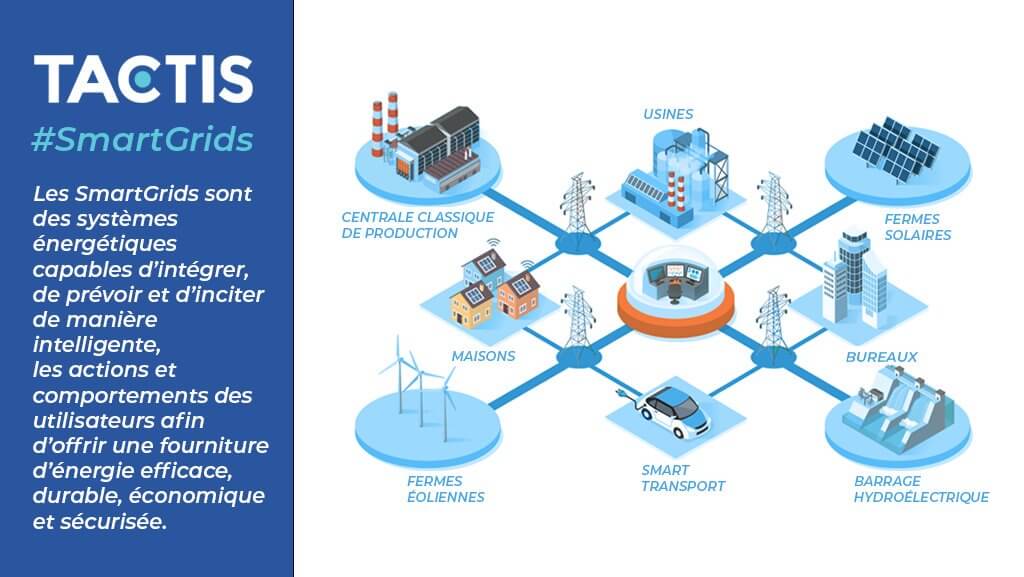What are Smart Grids? What are they?
According to the official definition of the French Environment and Energy Management Agency (ADEME), Smart Grids are energy systems capable of effectively and intelligently integrating, predicting and encouraging the actions and behaviour of the various users (consumers and producers) connected to them, in order to maintain an efficient, sustainable, economic and secure energy supply.
Why are we talking about electric Smart Grids ?

Smart Grids are the basis of the Smart Grids concept because of the historical penetration of automation and control systems for electricity production (until now highly centralised), transmission and distribution networks and consumption points (whether industrial, tertiary or residential).
Historically, the electricity grid has been established in such a way as to transmit energy flows unidirectionally, from generation plants (e. g. hydraulic, nuclear, thermal) to consumers (residential, tertiary, industrial). The network was therefore composed of a limited number of clearly identified producers to ensure that supply met demand at all times.
Today, smart grids allow decentralized energy producers to be integrated by monitoring two-way flows.
The stakes are high, especially since decentralized energy production is mainly based on photovoltaics and wind power, which are intermittent sources of energy by nature. Therefore, the same point in the grid, say a company with a fleet of photovoltaic panels, can be both a place of production and energy consumption depending on weather conditions.
A Smart Grid must therefore be able to instantly measure local energy production to ensure the power supply of equipment, interacting with the national grid to remove excess energy produced or to call up energy if local production is not sufficient.
An essential element of Smart Grids, the smart meter allows you to know precisely how much your network consumes. Better knowledge of energy consumption results in changes in virtuous behaviour to optimize the way people consume.
Therefore, in addition to making it possible to integrate renewable energies locally, Smart Grids are a concrete way of influencing energy consumption to meet current ecological challenges.
By way of illustration, smart power grids are typically deployable on the scale of a neighbourhood, a public place (e. g. cultural centre, shopping centre), or a factory.
Smart Gas Grids
Smart Gas Grids are intelligent gas networks that benefit from all the new digital technologies (sensors, data generators, etc.), with the objective of improving the efficiency of natural gas distribution. Their deployment serves four main strategic objectives for natural gas distribution system operators:
- The integration of renewable green gases (e.g. biomethane, synthetic methane, etc.). The integration of these green gases requires better control of their quality and composition, for a finer view of the network than before.
- The complementarity of networks ("power-to-gas"). The idea of "power-to-gas" is to facilitate the insertion of surplus electrical energy from renewable sources, by promoting their conversion into hydrogen or methane. Indeed, the excess electrical energy is used to supply processes for the transformation of water into hydrogen (by electrolysis) and/or hydrogen into methane (by methanisation by recycling CO2). The hydrogen or methane produced can be recovered in different ways: injected into natural gas networks, consumed for industrial purposes, converted back into electricity (via a fuel cell), or to power hydrogen vehicles. Associated technologies (e.g. mini CHP, hybrid electric/gas boiler systems, fuel cells, etc.) make it possible to better manage fluctuations in production and demand, with a low marginal cost.
- Controlling energy demand. The deployment of the gas meter and the use and availability of the data generated by the sensors allow a more accurate monitoring of gas consumption. This data, enriched by innovative equipment such as connected boilers, enables consumers to better understand and control their energy practices.
- Operational performance. The availability of the data collected makes it possible to have more efficient operation and maintenance tools, as well as to optimize the sizing of networks in relation to anticipated changes in production and consumption.
Thermal Smart Grids
There are 2 types of thermal networks: heating and cooling networks. A heating network is a heat distribution system that serves several users. A cooling network collects heat in the buildings and evacuates it to a cooling plant. These networks both have great potential for energy efficiency and the integration of renewable energy and recovery.
The deployment of digital technologies and intelligent sensors on these networks provides the opportunity to optimize their management by better anticipating peak heating periods and reducing energy losses, while favouring the least expensive sources (economically and environmentally).
These "intelligent" heating and cooling networks therefore allow dynamic management of thermal energy according to market conditions, as close as possible to final demand.
In addition to conventional energies (e.g. natural gas, fuel oil, coal, etc.), these networks can also include new energy sources such as recovery energies (e.g. fatal heat released by waste incineration, heat related to the operation of servers in a datacenter) and energies from renewable sources (e.g. biomass, biogas, solar thermal, etc.).
The recovery of caloric energy is an element to be integrated into the economic equation from the design phase of infrastructure projects, in a logic of valorizing heat emissions, lost or costly otherwise.
Smart Grids, an economic and social issue for communities
The implementation of Smart Grids creates value for the community around four major issues:
- A technical challenge: meeting the technical challenges of optimizing energy networks will make it possible to better exploit the tools of the digital revolution,
- An economic challenge: smart grids are a means of increasing economic attractiveness through innovation values, but also to access an efficient, secure, economic energy mix that generates local added value and creates local jobs,
- A societal challenge: local authorities will be able to better support citizens towards more ecologically virtuous energy behaviour by demonstrating that they are taking their responsibilities in the ongoing energy transition,
- An organizational challenge: it will be necessary to adopt new, more collaborative and agile ways of working and governance that will benefit communities. Smart grids are indeed a place where several verticals converge: electricity grid, mobility, heating network, communication.
Savings for communities
According to an analysis conducted byAssociation des Distributeurs d’Electricité en France (ADEeF), ADEME, Enedis and the Réseau de Transport d’Electricité (RTE) in 2017,
the economic value of smart grids lies mainly in the implementation of intelligent control systems (forecasting and dynamic management of distribution networks, capping solutions, flexibility), which could generate, by 2030, net benefits of around €400 million per year for all national authorities, including several tens of millions of euros for the public transport network. To this must also be added the profits made by public distribution system operators.
The savings and benefits identified by this analysis are as follows:
- Avoided investments in new production capacities and in the network,
- Optimization of the generating fleet, through participation in energy markets and through the various supply-demand balancing services,
- Optimisation of network operations, in particular by reducing undistributed energy, non-injected energy and network losses,
- Predictive analysis, by cross-referencing data, allowing the anticipation of failure risks with a high level of accuracy. This will allow communities to target maintenance or renewal operations as effectively as possible.
A valorization of public data for local authorities
The data collected or produced by the community as part of its public service mission enable it to better understand and manage its activity, but it may also use it with third parties to encourage the creation of new services for the benefit of citizens.
This data allows for example:
- To diagnose and act on energy consumption in the territories,
- To evaluate the opportunity to develop a development project in relation to the energy network,
- To dimension the energy production and distribution for a new district.
The data can thus be used to create consumption typologies and enrich the services offered. Electricity and gas managers therefore become data operators, which they provide to local authorities in compliance with the obligations related to the protection of personal data. The latter will be able to initiate a local public data service, which combines data from dealers with public data. Data aggregation is valuable in an "Open Data" approach, a vector of local innovations.
Some recommendations for the implementation of Smart Grids
The following is a non-exhaustive list of recommendations for communities to help frame the Smart Grids deployment process:
- Position Smart Grids as one of the drivers of the energy transition and digital transformation of the territory,
- Designate a referent among elected officials for Smart Grids deployments in the community, and upgrade the skills of Smart Grids correspondents to make them ambassadors for the approach,
- To have an exhaustive inventory of the areas likely to have an impact or interaction with the deployment of a smart grid (e.g. urban planning policy, social housing, the presence of a circular economy, etc.),
- Ensure the ownership of Smart Grids by local authorities: operators, consumers, subcontractors, stakeholders, etc..,
- Open a committee for consultation and citizen debate in order to ensure, among other things, the widest acceptability of technological solutions,
- Ensure support for the deployment of communicating meters, and more generally digital tools for collecting data to help decision-making,
- Monitor and evaluate available private and public funding, as well as legal and contractual developments that support the deployment of Smart Grids to seize opportunities,
- Anticipate the rise in the quality of services made possible by new energy and communications network infrastructures (e.g. the Internet of Things),
- Propose Smart Grids Ready buildings in urbanization schemes,
- Lead a local innovation approach on smart grids by contacting the nearest competitiveness clusters, local energy agencies, Chambers of Commerce and Industry, etc.
External sources
www.ecologique-solidaire.gouv.fr

Benjamin Fradelle
Contact Benjamin Fradelle
Hello, do you have a question about Smart Grids ? Need to remove doubts in view of a future project? Send an email to Benjamin Fradelle, Tactis Associate Director.



